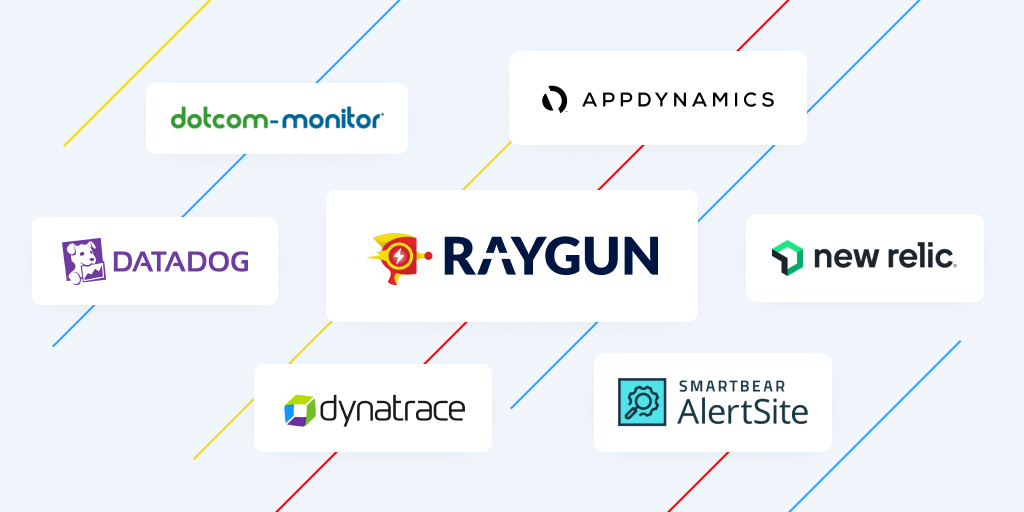The 29 best DevOps tools for 2023 and beyond
Posted May 12, 2023 | 30 min. (6292 words)The integration of Development and Operations is a powerful innovation in how we build software. If you’re new to DevOps practices, or looking to improve your current processes, it can be tough to know which tool is best for your team.
We’ve put together this list to help you make an informed decision on which tools should be part of your stack. Read on to discover the 29 best DevOps tools, from automated build tools to application performance monitoring platforms.
In this post
- What are DevOps tools?
- Source code management and build tools
- Git
- Mercurial
- Apache SVN
- Jira
- Sonarqube
- Gradle
- Containerization platforms
- Docker
- Redhat Openshift
- Kubernetes
- LXC/LXD
- Apache Mesos
- CI/CD and deployment tools
- Jenkins
- Bamboo
- Amazon ECS
- Octopus
- CircleCI
- Configuration management tools
- Puppet
- Chef
- Ansible
- SysAid
- Cloud DevOps tools
- Atlassian Open DevOps
- Azure DevOps
- AWS DevOps
- Terraform
- Google Cloud Build
- Monitoring and error reporting platforms
- Raygun
- OpsGenie
- Nagios
- Firebase Crashlytics
What are DevOps tools?
“DevOps tools” is an umbrella term that includes all the platforms, tools, servers, and other applications used in a relatively new software development life cycle (SLDC) model called DevOps. The DevOps methodology is a set of practices that combines the development and operations phases of the life cycle and manages them as one integrated workflow.
DevOps tools encompass the entire software development lifecycle from code reviews and version control to deployment and monitoring. The main goals of DevOps are to make frequent software releases possible, automate as many tasks and processes as possible, and improve the speed of development and scalability. DevOps tools and practices are relevant right from the earliest parts of the development stage to the final, critical addition of an error monitoring solution like Raygun to give you full visibility and control over the quality of your code in action.
Depending on your business needs, you’ll most likely require a range of DevOps tools that will communicate with each other using integrations, extensions, automations, APIs, or other means.
The best DevOps tools for 2023
We’ll start with the development stage of the DevOps cycle, then look at the operations stage.
While we’ve put these into broad categories, it’s important to note that there can be overlaps between the functionality of these DevOps tools — sometimes you can perform the same action with different types of tools, and you can use them in several distinct combinations in your DevOps stack.
Source code management and build tools
The DevOps lifecycle starts with creating, storing, analyzing, and reviewing your source code. Source code management includes tasks such as version control, issue tracking, code review, packaging, and more.
1. Git: Distributed source code management and version control system
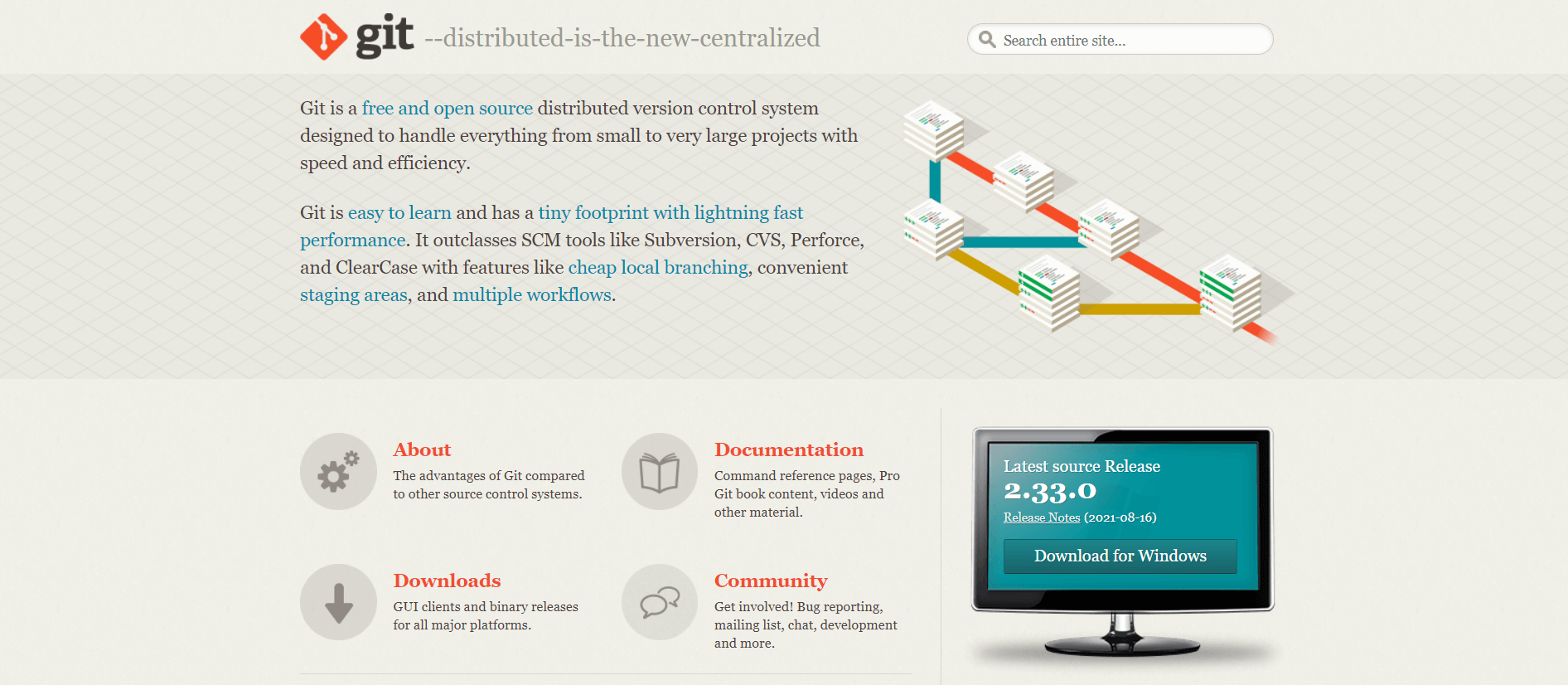
Git is one of the most popular DevOps tools, widely used across the software industry. It’s a distributed SCM (source code management) tool, loved by remote teams and open-source contributors. Git allows you to track the progress of your development work. You can save different versions of your source code and return to a previous version when necessary. It’s also great for experimenting, as you can create separate branches and merge new features only when they’re ready to go.
By default, Git is a command line tool, but you can also download the GUI client that lets you manage your source code from a user-friendly graphical interface. Many source code editors such as Visual Studio Code also come with a built-in Git editor tool.
To integrate Git with your DevOps workflow, you also need to host your source code in repositories where your team members can push their work. Currently, the most popular online Git repo hosting services are Github, Gitlab, and Bitbucket. You can host both public and private repositories on these platforms, track and discuss issues, and manage releases. They also provide you with additional DevOps features, such as built-in continuous development and security functionalities, code review, auditing and collaboration tools, and more.
2. Mercurial
Mercurial is a free-to-use, distributed revision control tool written in Python and supported on Windows and Unix. COmpared to Git, it’s generally considered to be a good option for less experienced developers, with a less complex structure and syntax and simple and intuitive command-line interface. Mercurial tracks changes to keep your entire team working with the correct version of your code.
Mercurial’s distributed model means each user has a full copy of the repository on their machine, often thought to be a faster, more flexible method of working. It uses named branching, with each branch as an individually named line of development.
Mercurial is also quite scalable, performing well at handling large codebases, and it comes with a plugin architecture that enables developers to customize at will. It’s compatible with major hosting services, including GitHub, Bitbucket, and Google Code.
Mercurial also provides robust security, supporting authentication and authorization to control access to the codebase. Additionally, it provides encryption for data in transit and at rest to ensure that code and other data are kept secure.
3. Apache SVN
Apache SVN (Subversion) is a source-code management tool for version control to manage and track changes. Apache SVN is well-suited to handle large codebases and manage multiple versions of code simultaneously. It’s designed to be integrated with other DevOps tools, especially other Apache products like Maven.
SVN uses a centralized repository model, so everyone is working on the same version, reducing the risk of conflicts or version control issues. The branching model makes it easy to create branches of the codebase for experimental or feature-specific work, and then merge those changes back into the main codebase when they’re ready.
SVN versioning tracks changes to source code over time, allowing teams to easily revert to previous versions if necessary. This is particularly useful in DevOps teams, where rapid development and deployment can lead to the introduction of issues that need to be fixed quickly. SVN also allows teams to control access to the codebase, ensuring that only authorized users can make changes or access sensitive information. Security is an especially relevant concern for DevOps teams and integrated throughout the DevOps cycle.
4. Jira: Issue and project tracking platform
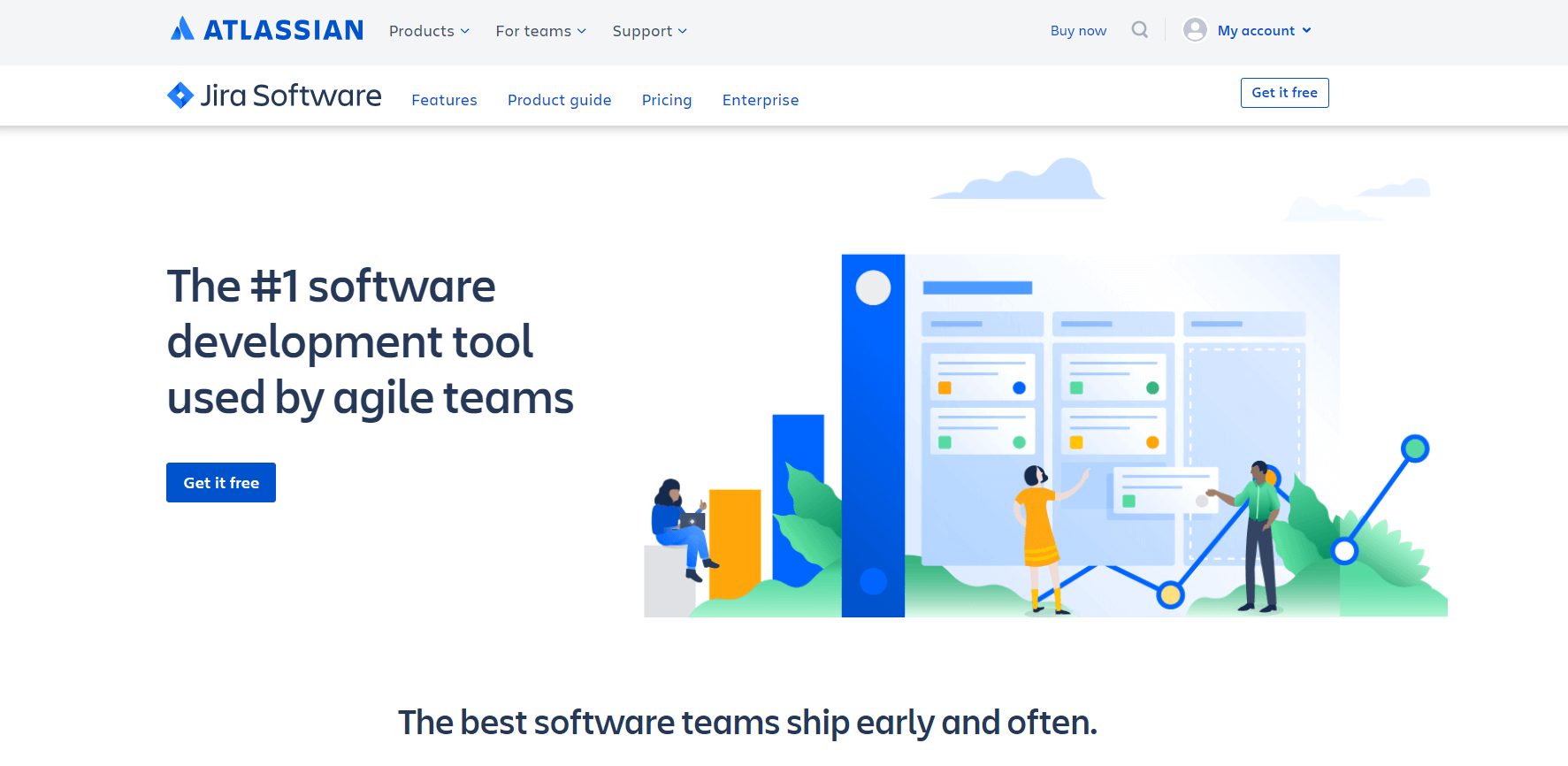
Jira is a popular issue tracking and project management platform. It’s a product of Atlassian, a major IT company that develops several prominent software tools, including Confluence, Bitbucket, Trello, and Statuspage. You can use Jira either as SaaS or on-premise.
Jira started as a bug tracking tool and that’s how many developers still think of it, but it’s a lot broader than that now. Its user-friendly interface allows you to see the development status of your projects in context, create branches and pull requests, view commits, manage dependencies and releases, visualize progress, and more.
Jira’s project management features were added later and complement the bug tracking capabilities. As Jira focuses on Agile software development (i.e. methodologies that center around iterative development), it comes with Scrum and Kanban boards (two competing implementations of Agile), roadmaps, and advanced reporting tools.
Jira also has an advanced automation engine that enables you to build automation rules using a handy drag-and-drop interface. Not only can you automate Jira tasks, you can also connect to tools like Bitbucket, GitHub or Microsoft Teams, and include them in your automation workflows. Jira’s integrations are a critical part of its value, as it’s a core component of the Atlassian Open DevOps suite of cloud tools (more on that later).
5. SonarQube: Automated code review tool
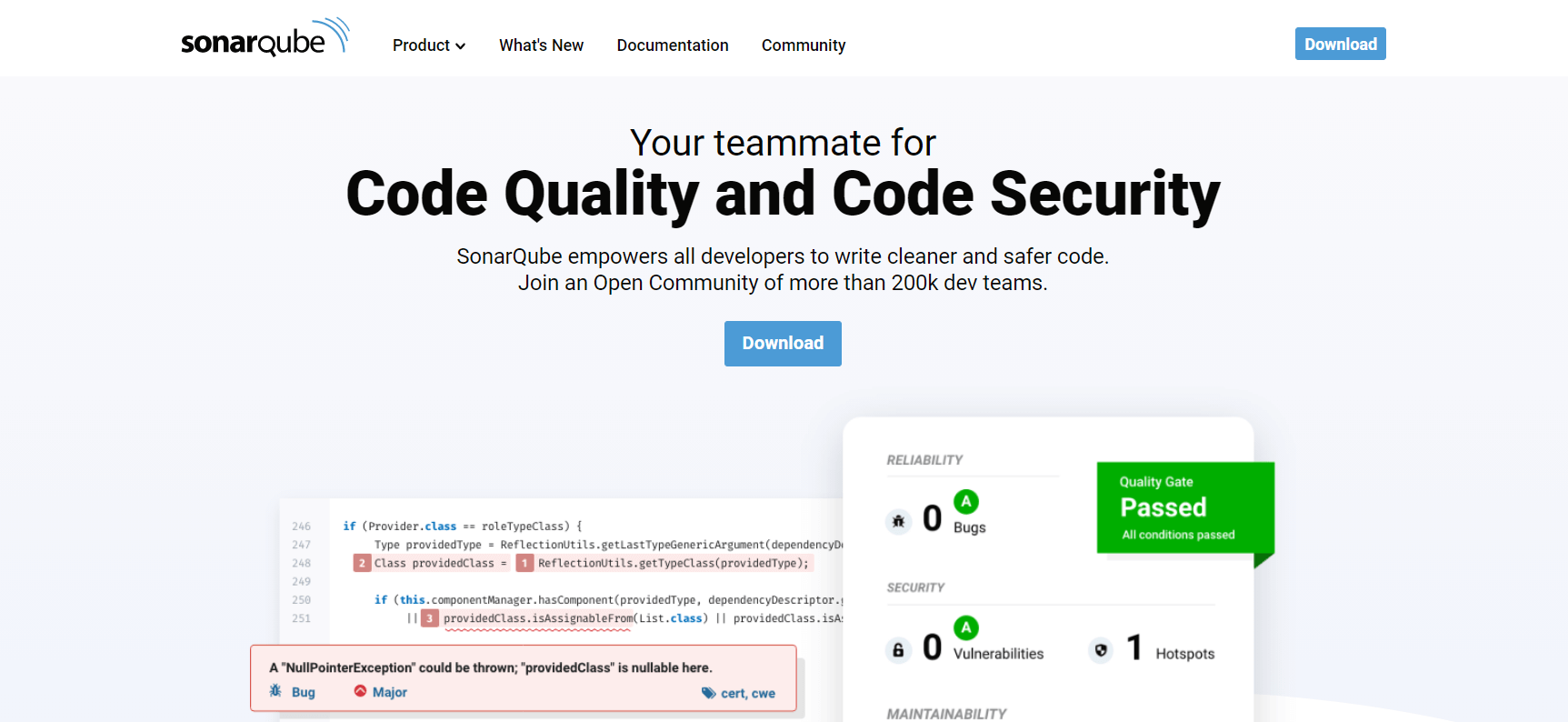
SonarQube is an open-source code review tool (see GitHub repo) that supports 27 programming languages. It’s ideal for analyzing the source code of applications written in multiple languages. It helps you keep the focus on code quality and security during the entire development process by automatically checking your code base against thousands of static code analysis rules.
Quality gates are SonarQube’s most notable feature. SonarQube scores your source code for bugs, vulnerabilities, code smells, coverage, and duplications, and assesses whether it passes the “quality gate” for public release. You can also use quality gates to analyze pull requests so you can quickly decide whether to merge them or not.
In addition to analyzing overall code health, SonarQube also highlights newly introduced issues. Plus, it provides you with useful visualizations that provide insight into the overall state of your code base. It works both in the cloud and on-premises and integrates with many DevOps tools, including GitHub, GitLab, Jenkins, Azure Pipelines, Bitbucket, and others. You can set SonarQube up with minimal configuration.
As SonarQube helps improve security by introducing continuous code inspection into your DevOps workflow, it’s also seen as one of the best DevSecOps tools.
6. Gradle: Multi-language build automation tool

Your DevOps stack needs a reliable build tool. Apache Ant and Maven dominated the market for years, but Gradle’s popularity has steadily grown since it showed up on the scene in 2009. Gradle is a versatile tool that supports multiple programming languages, including Java, C++, Python, and others. It’s also supported by popular IDEs (Integrated Development Environments) such as Netbeans, Eclipse, and IntelliJ IDEA. Plus, Google selected Gradle as the official build tool for Android Studio.
While Maven and Ant use XML for configuration, Gradle uses a Groovy-based DSL (domain-specific language) for describing builds. In addition to the default DSL, the Gradle team also released a Kotlin-based DSL to enable developers to write their build scripts in Kotlin. Gradle supports multiple repository formats including Maven-compatible artifact repositories, so dependency management will be familiar if you have prior experience with Maven. You can also import your Ant builds into Gradle.
Gradle allows you to use incremental builds that check if inputs and outputs have changed since the last run. This feature saves a significant amount of compile time — according to Gradle’s performance measurements, it’s up to 100 times faster than Maven. This performance gain is achieved partly by incrementality, and partly by Gradle’s build cache and daemon (background process). The build cache reuses task outputs, while the Gradle Daemon keeps build information hot in memory in-between builds.
All in all, Gradle allows faster shipping and comes with a lot of configuration options.
Source code management and build tools: comparison table
| Tool | Version Control | Collaboration | Integration | Scalability | Performance |
|---|---|---|---|---|---|
| Git | ✔️ | ✔️ | ✔️ | ✔️ | ✔️ |
| Mercurial | ✔️ | ✔️ | ✔️ | ✔️ | ✔️ |
| Apache SVN | ✔️ | ✔️ | ✔️ | ✔️ | ❌ |
| Jira | ❌ | ✔️ | ✔️ | ✔️ | ❌ |
| Sonarqube | ❌ | ❌ | ✔️ | ✔️ | ❌ |
| Gradle | ❌ | ❌ | ❌ | ✔️ | ✔️ |
Containerization platforms
Containerization is a lightweight form of virtualization that packages up the source code of an application and all its dependencies as a container image, so that it can be deployed to different environments without further configuration.
7. Docker: Open-source containerization platform
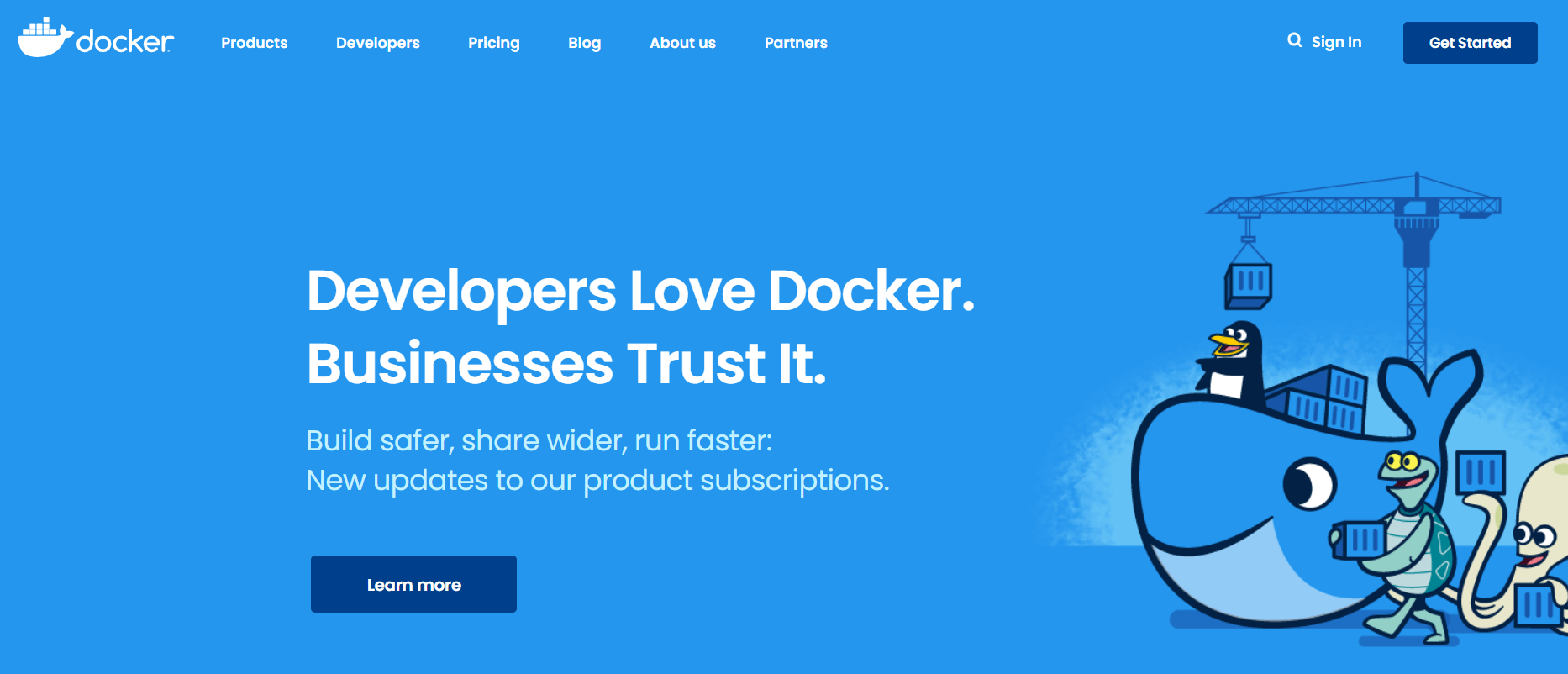
Docker has been the number one container platform since its launch in 2013, and it continues to improve. It’s widely regarded as one of the most important DevOps tools. Docker has made containerization popular in the tech world, mainly because it makes distributed development possible and helps automate the deployment process. It isolates applications into separate containers, so they become portable across environments and more secure. Docker apps are OS- and platform-independent. You can use Docker containers instead of virtual machines such as VirtualBox.
With Docker, you don’t have to worry about dependency management. You can package all dependencies within the app’s container and ship the whole thing as an independent unit. Then, you can run the app on any machine or platform.
Docker integrates with Jenkins and Bamboo (see both below), too. Using it together with one of these CI/CD servers can further improve your DevOps workflow. Docker is also widely used in cloud computing, as all major cloud providers (including Amazon Web Services and the Google Cloud Platform) come with Docker support. So if you’re planning a cloud migration, Docker can ease the process for you.
8. Redhat Openshift
Redhat Openshift is an open-source Kubernetes platform that provides a comprehensive set of tools for deploying, scaling, and managing containerized applications. It’s built on top of Kubernetes and is designed to help teams streamline their application development and deployment workflows.
OpenShift covers a range of deployment options, including on-premises, public, and hybrid cloud deployments. It also includes a range of developer tools, including integrated development environments (IDEs), code editors, and continuous integration and delivery (CI/CD) tools, to consolidate your development toolkit.
OpenShift prioritizes security as a feature, with encryption, network security policies, and secure access controls, plus container images that are certified for use with government and industry security standards.
OpenShift’s automation options cover deployment, scaling, and management of applications. OpenShift also provides monitoring and logging capabilities.
9. Kubernetes: Automated container-orchestration platform
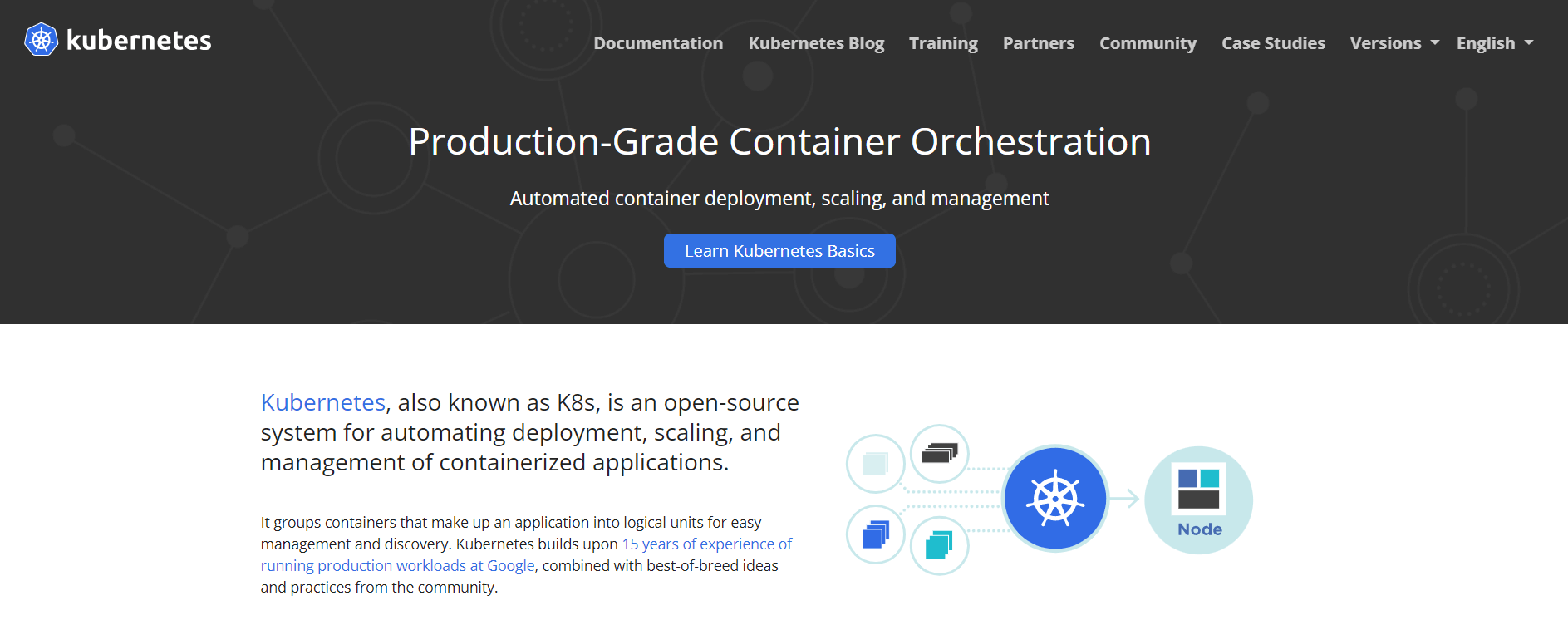
Kubernetes is a container orchestration platform that takes container management to the next level. It was founded by a couple of Google engineers who wanted to find a solution to manage containers at scale. Kubernetes works well with Docker or any of its alternatives to help you group your containers into logical units.
You may not need a container orchestration platform if you have only a few containers. However, it’s the next logical step once you reach a certain level of complexity and need to scale your resources. Kubernetes allows you to automate the process of managing hundreds or thousands of containers.
With Kubernetes, you don’t have to tie your containerized apps to a single machine. Instead, you can deploy to a cluster of computers, with Kubernetes automating the distribution and scheduling of containers across the whole cluster.
A Kubernetes cluster consists of one master and several worker nodes. The master node implements your pre-defined rules and deploys the containers to the worker nodes. Kubernetes monitors everything to prevent mishaps - for example, it will notice when a worker node is down and redistribute the containers.
10. LXC/LXD
LXC (Linux containers)/LXD (Linux Container Daemon) is a containerization platform for Linux that provides a lightweight alternative to virtual machines. It allows you to create and manage Linux containers with their own file system and network interfaces.
LXD provides a higher-level interface for managing containers and includes features such as live migration, snapshots, and clustering, plus a REST API and a command-line client. LXC provides a low-level container runtime that allows you to create and manage containers directly from the command line. It supports a range of Linux distributions and allows you to customize container settings such as CPU, memory, and network access.
LXC/LXD is well-suited for a range of use cases, including development and testing, container-based deployments, and cloud computing. It provides a lightweight and efficient way to create isolated environments, and with its flexible and customizable architecture, it can be integrated into a range of infrastructure setups and workflows.
11. Apache Mesos
Apache Mesos is an open-source distributed systems kernel used for resource management and scheduling across clusters of servers to build fault-tolerant distributed applications. Mesos provides a level of abstraction that allows teams to manage CPU, memory, and storage as a single pool across a data center or cloud infrastructure.
Mesos is widely used in large-scale production deployments. It’s designed to work with other distributed systems and provides a unified API for running distributed applications. Notable features include dynamic resource allocation, automatic failover, and support for custom schedulers.
With Mesos, you can run different types of workloads, such as containerized and non-containerized applications, side-by-side on the same cluster. Mesos also supports various container orchestration frameworks, including Docker, Kubernetes, and Apache Aurora. Mesos provides a scalable and resilient architecture that ensures high availability and reliability.
Containerization tools: comparison table
| Tool | Orchestration | Security | Networking | Image management | Performance |
|---|---|---|---|---|---|
| Docker | ✔ | ✔ | ✔ | ✔ | ✔ |
| Redhat Openshift | ✔ | ✔ | ✔ | ✔ | ✔ |
| Kubernetes | ✔ | ✔ | ✔ | ✔ | ✔ |
| LXC/LXD | ✖ | ✔ | ✔ | ✔ | ✔ |
| Apache Mesos | ✔ | ✔ | ✔ | ✖ | ✔ |
CI/CD and deployment tools
CI/CD stands for continuous integration and continuous delivery/deployment. Continuous integration is a software development practice that merges the work of all developers working on the same project, while continuous delivery ensures reliable and frequent releases.
In DevOps culture, the two practices are combined into a single CI/CD solution, to enable teams to ship releases effectively, reliably, and frequently.
12. Jenkins: Open-source automated CI/CD server
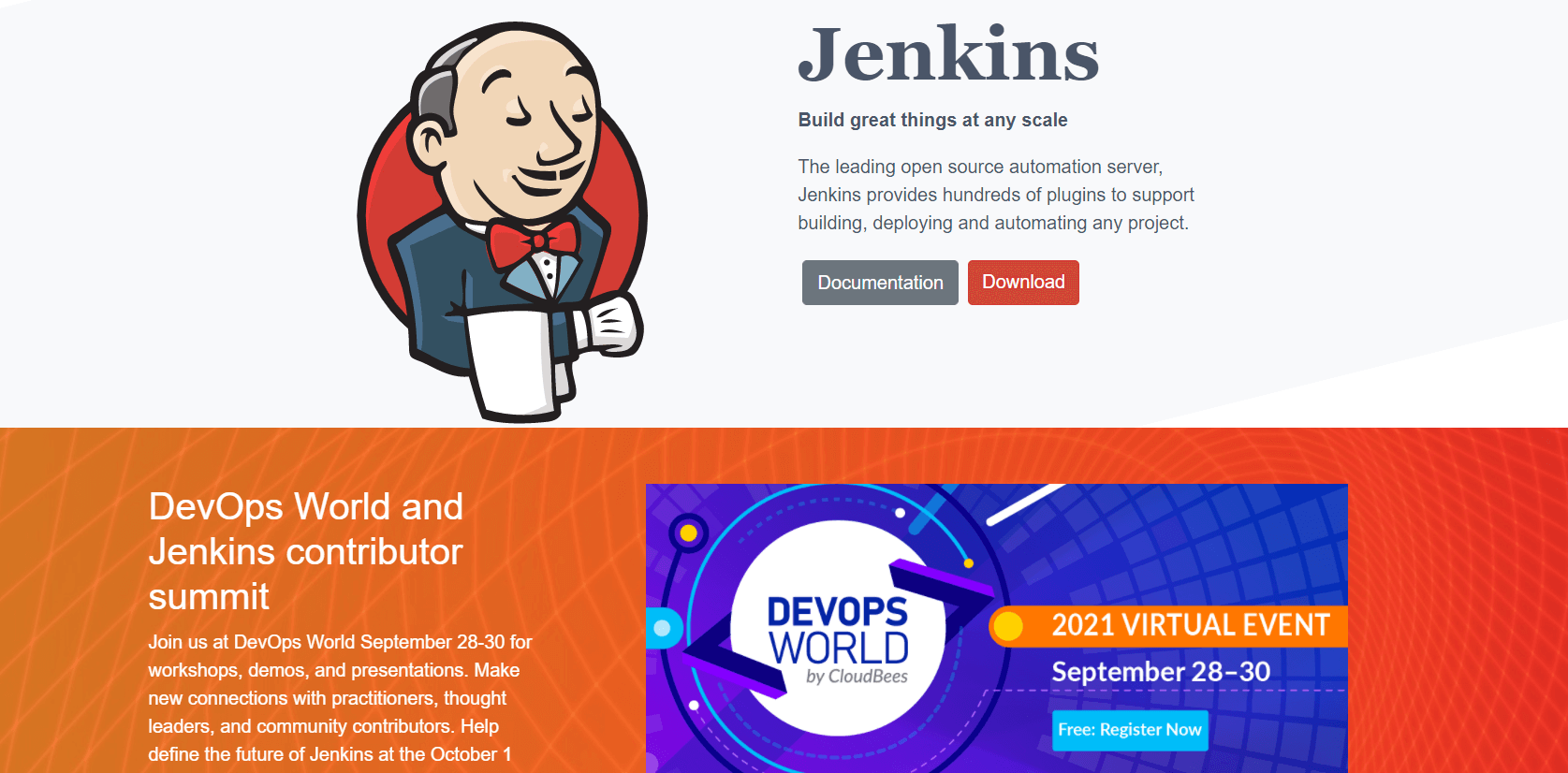
Jenkins is one of the most popular DevOps automation tools in the market. It’s an open-source CI/CD server that allows you to automate the different stages of your delivery pipeline. The main reason for Jenkins’ popularity is its huge plugin ecosystem. With more than 1,800 plugins, it integrates with almost all DevOps tools, including Docker, Puppet, Octopus Deploy, and more.
With Jenkins, you can set up and customize your CI/CD pipeline according to your own needs. It’s easy to get started with Jenkins, as it runs natively on Windows, Mac OS X, and Linux. It’s easily installed with Docker. You can set up and configure your Jenkins server through a web interface. If you’re a first-time user, you can choose to install it using plugins or create your own custom configuration.
With Jenkins, you can iterate and deploy new code as quickly as possible. It also allows you to measure the success of each step of your pipeline. You can use it either as a simple CI server solely on the development side or as a complete CI/CD solution that also takes care of your deployment workflow.
13. Bamboo: Commercial automated CI/CD server

Bamboo is Atlassian’s CI/CD server solution, and has many similar features to Jenkins. Both are popular DevOps tools that allow you to automate your delivery pipeline from builds to deployment. However, while Jenkins is open-source, Bamboo comes with a price tag. So, is it worth choosing proprietary software over a free alternative? It depends on your budget and goals.
Bamboo has many pre-built functionalities that you have to set up manually in Jenkins. This is also the reason why Bamboo has fewer plugins (around 190 compared to Jenkins’ 1,800+). And actually, you don’t need a lot of plugins with Bamboo, as it does many things out of the box.
Bamboo seamlessly integrates with other Atlassian products such as Jira and Bitbucket. You also have access to built-in Git and Mercurial branching workflows and test environments. The bottom line is that Bamboo can save you a lot of configuration time. It also comes with a more intuitive UI with tooltips, auto-completion, and other handy features.
14. Amazon ECS
Amazon Elastic Container Service (ECS) is AWS’ fully-managed container deployment and management service. It’s pitched as easy deployment and management of containerized applications on a scalable, secure, and highly available infrastructure.
ECS is accessible and easy to use. It integrates with other AWS services like ELB and EBS to provide a unified platform for container deployment, and runs a web-based management console and command-line tools.
ECS automatically scales containers up or down based on demand, keeping your applications available and responsive. It provides built-in load balancing and health monitoring features to make sure that applications can handle high-traffic loads. Deployment options include rolling deployments and blue-green deployments.
ECS provides secure access to containers and resources through IAM policies and encryption and integrates with AWS security tools like Identity and Access Management (IAM) to provide role-based access control (RBAC) and compliance with security standards such as HIPAA and PCI-DSS.
15. Octopus Deploy: Automated deployment and release management platform

Octopus Deploy is an advanced deployment and release management tool. It allows you to automate your deployment process across multiple environments and releases, and can be used together with CI/CD servers such as Jenkins or Bamboo to trigger an Octopus deployment after every build. Octopus then creates a new release and deploys it to different environments, including development, testing, staging, production, and other environments.
Use Octopus Deploy to package your application as a ZIP, .tar.gz, JAR/WAR, or NuGet file. You can define your own deployment process that Octopus will run automatically, but if you need some inspiration, Octopus has an extensive deploy library that lists almost 500 templates of frequent deployment workflows.
Octopus Deploy supports multiple cloud services, so you can easily deploy your application straight to the cloud. It also has a feature called ‘runbooks’ to automate common emergency operation tasks such as website failover and restoration. Runbooks include all the necessary permissions the different elements of your infrastructure require, so even our non-technical team members can run them.
A deployment management tool such as Octopus Deploy is recommended if you have a complex deployment workflow consisting of several environments (called ‘deployment targets’ by Octopus).
16. Circle CI
CircleCI is a CI/CD platform that automates the build, test, and deployment processes. It’s a cloud-based service supporting a wide range of programming languages and frameworks, including Ruby, Python, Java, Node.js, and Go. It also integrates with messaging platforms like Slack and email to notify you of build status and failures in real-time.
CircleCI allows teams to set up automated workflows, or pipelines, to build, test, and deploy code changes each time they’re pushed to a repository. These pipelines are defined in a configuration file that can be version-controlled alongside the codebase, allowing for collaboration and easy reproduction of builds. It also lets you monitor the status of your builds, as well as view logs and test results.
One of the key appeals of CircleCI is its scalability. It can handle builds for small projects with a few developers, as well as large-scale applications with complex deployment processes. It also integrates with popular DevOps tools like Docker, Kubernetes, and AWS, making it easy to deploy applications to a variety of environments.
CI/CD and deployment tools: comparison table
| Tool | Integration | Pipeline management | Scalability | Security | Automation |
|---|---|---|---|---|---|
| Jenkins | ✔ | ✔ | ✔ | ✔ | ✔ |
| Bamboo | ✔ | ✔ | ✔ | ✔ | ✔ |
| Amazon ECS | ✔ | ✔ | ✔ | ✔ | ✔ |
| Octopus | ✔ | ✔ | ✔ | ✔ | ✔ |
| CircleCI | ✔ | ✔ | ✔ | ✔ | ✔ |
Configuration management tools
Configuration management tools speed up deployment by automating the maintenance, configuration, and orchestration processes of your entire infrastructure.
16. Puppet Enterprise: A platform-independent configuration management platform
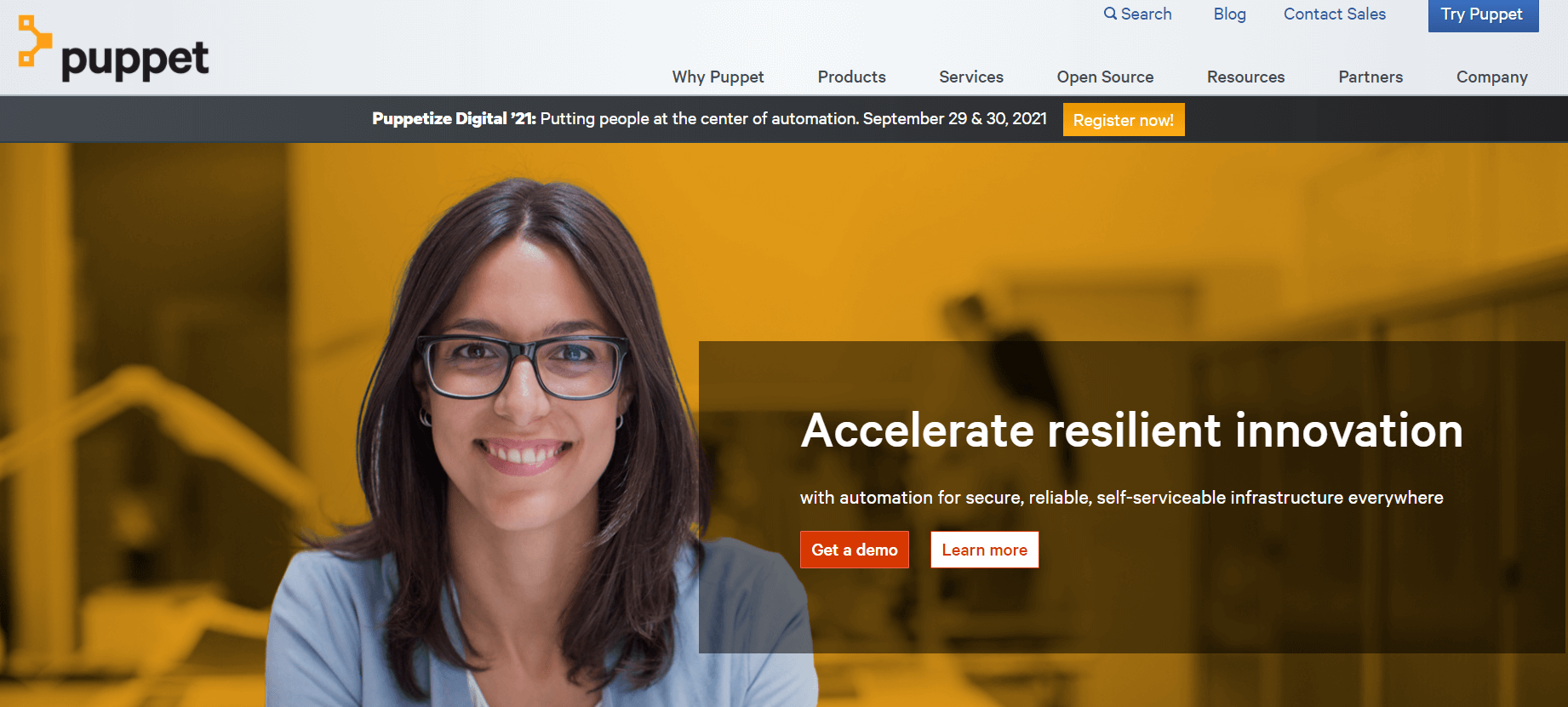
Puppet Enterprise is a cross-platform configuration management platform. It allows you to manage your infrastructure as code. As it automates infrastructure management, you can deliver software faster and more securely. Puppet also provides developers with an open-source tool for smaller projects.
If you’re dealing with a larger infrastructure, you might find value in Puppet Enterprise’s extra features, such as:
- Real-time reports
- Role-based access control
- Node management
With Puppet Enterprise, you can manage multiple teams and thousands of resources. It automatically understands relationships within your infrastructure. It deals with dependencies and handles failures smartly. When it encounters a failed configuration, it skips all the dependent configurations as well. Puppet has more than 6,700 modules and integrates with many popular DevOps tools.
17. Progress Chef
Progress Chef (or just ‘Chef’) is a popular open-source configuration management tool used to automate the deployment and management of infrastructure and applications. It allows teams to manage infrastructure as code, enabling them to define, configure, and deploy in a repeatable and consistent way.
Chef provides a simple and declarative language for describing infrastructure, allowing you to specify how each component should be configured. This makes it easier to manage and automate deployments across multiple environments.
Chef also has a powerful ecosystem of community-maintained “cookbooks” providing pre-built recipes for common infrastructure components, such as web servers, databases, and load balancers. This helps new users to configure systems without having to write all the code from scratch. Chef is scalable and flexible, and can be used to manage infrastructure of any size, from one to thousands of servers.
Chef provides comprehensive reporting and analytics features, enabling you to monitor the status and performance of your infrastructure and applications in real-time, and rich visualization capabilities, allowing you to quickly identify and diagnose issues.
18. Ansible: A YAML-based configuration management tool
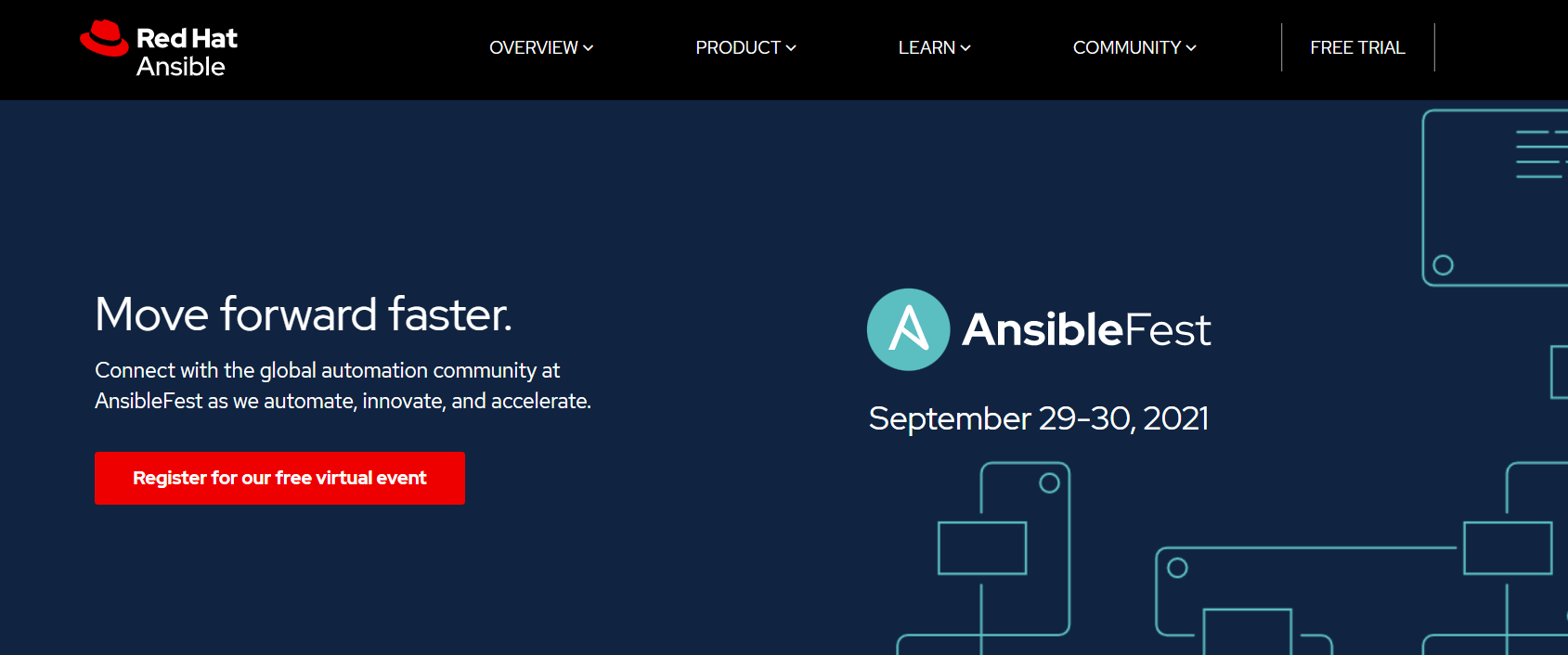
Ansible is an open-source configuration management tool sponsored by Red Hat. In functionality, it’s similar to DevOps automation tools on the deployment end of the CI/CD pipeline like Puppet (see above) and Chef. You can use it to configure your infrastructure and automate deployment. Compared to similar DevOps tools, its main selling points are simplicity and ease of use. Ansible follows the same Infrastructure-as-Code (IAC) approach as Puppet. However, it uses the super-simple YAML (Yet Another Markup Language) syntax. With Ansible, you can define tasks in YAML, while Puppet has its own declarative language.
Agentless architecture is another frequently mentioned feature of Ansible. As no daemons or agents run in the background, Ansible is a secure and lightweight solution for configuration management automation. Similar to Puppet, Ansible also has multiple modules.
If you want to better understand how Ansible fits into the DevOps workflow, take a look at this post by the Red Hat Blog, showing how to use Ansible for environment provisioning and application deployment within a Jenkins pipeline.
19. SysAid
SysAid is a cloud-based IT service management (ITSM) solution made up of a set of management tools, including asset management, incident management, and change management.
SysAid’s configuration management tool can automate and streamline the process of tracking and managing IT assets. It provides a single source of truth for all your assets and configurations, allowing teams to quickly identify and resolve issues. With SysAid, you can easily track all IT assets across your organization, hardware or software. You can also define and manage relationships between assets, enabling you to see the impact of changes.
SysAid provides a powerful search capability that allows you to quickly locate and access any asset or configuration item. With a range of reporting and analytics features, your team can track and monitor key performance indicators (KPIs) and identify areas for improvement. It also integrates with other ITSM modules. For example, if a configuration item is associated with an incident or a change request, SysAid automatically updates the asset record.
SysAid also provides a range of automation features to streamline repetitive tasks and workflows, automating updates to asset records when a new device is added to the network, or change requests when a configuration item is modified.
| Feature | Puppet | Chef | Ansible | SysAid |
|---|---|---|---|---|
| Declarative Language | ✔ | ✔ | ✔ | ✘ |
| Agentless | ✘ | ✘ | ✔ | ✘ |
| Scalability and Distributed | ✔ | ✔ | ✔ | ✔ |
| Platform and Technology Support | ✔ | ✔ | ✔ | ✘ |
| Community and Ecosystem | ✔ | ✔ | ✔ | ✘ |
Cloud DevOps tools
These days, it’s possible to run your entire DevOps stack in the cloud, using the managed DevOps solutions of cloud service providers.
21. Atlassian Open DevOps
Atlassian Open DevOps is a comprehensive suite of software development and ops tools to build, test, and deploy applications. This consists of a range of prominent tools (some of which are included on this list) that are designed to work together seamlessly, including Jira, Bitbucket, Confluence, and Bamboo.
The star of the Atlassian Open DevOps suite is Jira, the famous issue tracking and project management tool. Jira’s flawless integrations with Git-based code repository Bitbucket and documentation and collaboration tool Confluence are a big competitive advantage for Atlassian.
Aside from these core tools, Atlassian Open DevOps suite also includes a range of other tools and integrations, like Statuspage for communicating with customers during downtime. The number of tools and integrations on offer are a major part of the suite’s success, providing convenience, flexibility and customizability.
22. Azure DevOps Services: Microsoft’s cloud-based integrated DevOps platform
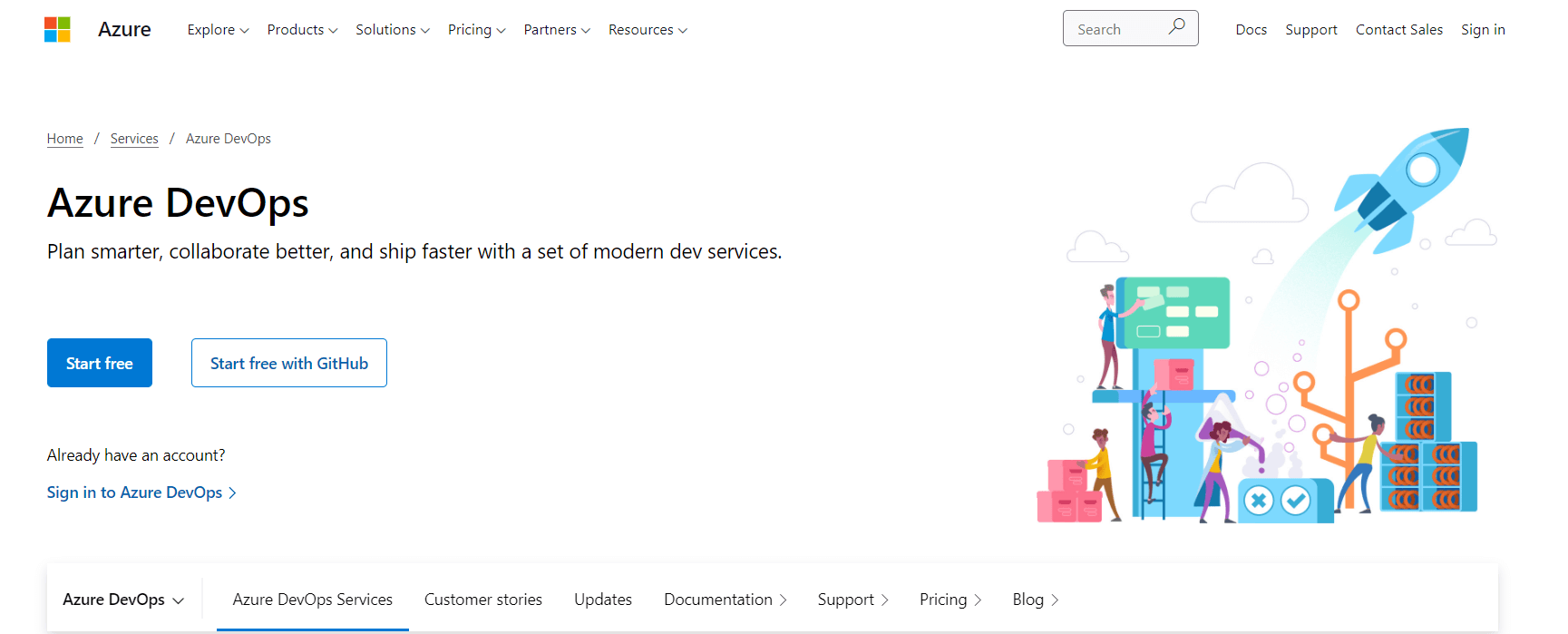
Azure DevOps (formerly known as Visual Studio Team System or VSTS) is Microsoft’s integrated DevOps platform. It enables you to manage your entire DevOps cycle from one integrated interface. While Azure DevOps Services is a cloud DevOps tool that you can use as a SaaS (Software-as-a-Service) application, Azure DevOps Server is the on-premise version of the same tool that you can self-host in your own data center.
Microsoft’s DevOps solution is a collection of tools, each addressing a different stage of your workflow. Azure Boards helps with planning and project management, Azure Pipeline is a CI/CD tool, Azure Repos includes cloud-hosted Git repos, Azure Test Plans is a testing toolkit, and Azure Artifacts let you create, manage, and deploy packages.
However, you don’t have to use all the tools included in Azure DevOps Services if you don’t want to, as you can also subscribe to them individually. If you need any additional features, you can also find more than 1,000 Azure DevOps extensions in the Visual Studio Marketplace, such as integrations, analytics, visualizations or crash reporting.
13. AWS DevOps: Amazon’s cloud-based DevOps toolkit

AWS DevOps is a part of Amazon Web Services and consists of a set of integrated DevOps tools that let you manage your entire software development lifecycle. Even though AWS is primarily used in the cloud, you can also run all the tools on-premise, with the help of AWS Outposts that let you install any element of the AWS infrastructure on your own in-house server.
Unlike Azure DevOps Services, which is a PaaS (Platform-as-a-Service), AWS is an IaaS (Infrastructure-as-a-Service) solution — so it’s tightly linked to the underlying infrastructure. While you can deploy packages from Azure DevOps Services to another infrastructure such as AWS, the reverse is isn’t possible. From AWS DevOps, you can only deploy to the AWS infrastructure like EC2 (Elastic Compute Cloud) or S3 (Simple Storage Service).
In the AWS DevOps toolkit, you can find a CI/CD service called AWS CodePipeline, a fully managed build tool called AWS CodeBuild, a deployment automation tool called AWS CodeDeploy, a DevOps project management platform called AWS CodeStar, and more. Overall, AWS DevOps is likely the best DevOps platform for current or future users of Amazon Web Services.
24. Terraform
Terraform is an open-source infrastructure-as-code (IaC) tool for managing and provisioning resources across cloud platforms and services. With Terraform, developers can write code to define and configure infrastructure resources, like virtual machines, containers, load balancers, and databases.
Terraform uses a declarative syntax to describe the desired state of infrastructure resources. You define the state in code, and Terraform ensures that the actual state of your infrastructure matches your desired state, providing a faster and more reliable way to automate the creation, modification, and deletion of resources.
Terraform covers infrastructure resources across multiple cloud platforms and services and supports a wide range of cloud providers, including Amazon Web Services (AWS), Azure, and Google Cloud Platform (GCP). This lets teams manage infrastructure resources across different cloud providers with a single, consistent set of tools and code.
Terraform can also facilitate infrastructure management at scale, letting you create and manage resources using modules, reusable blocks of code that can be repurposed across different projects and teams. This makes it easier to manage large and complex infrastructure environments, as developers can leverage pre-built modules and avoid duplicating code and effort. Terraform’s plan-and-apply workflow is also popular, helping developers to preview and validate changes before applying them.
Terraform is becoming an increasingly popular choice for organizations looking to automate and streamline their infrastructure management workflows.
25. Google Cloud Build
Google Cloud Build is a fully-managed CI/CD platform that lets you build, test, and deploy applications on Google Cloud Platform (or any other cloud provider). It supports a range of languages and frameworks, plus integrations with the usual source code repositories like GitHub and Bitbucket. With Cloud Build, you can automate your entire CI/CD pipeline, including building and testing your code, and deploying it to any environment.
Google Cloud Build uses a declarative YAML-based configuration file called a “cloudbuild.yaml” file, which defines the steps of the build process. It supports a range of build environments, including Docker, and allows you to customize your builds with custom build steps and plugins. It provides advanced features such as build triggers, which allow you to automatically start builds based on events in your source code repository.
Google Cloud Build is comprehensive, so you don’t need to worry about maintaining infrastructure or managing build agents, and you only pay for what you use. It also integrates with other Google Cloud Platform services, such as Google Kubernetes Engine and Google App Engine, making it easy to deploy your applications to production environments.
| Feature | Atlassian Open DevOps | Azure DevOps | AWS DevOps | Terraform | Google Cloud Build |
|---|---|---|---|---|---|
| CI/CD Pipelines | ✔ | ✔ | ✔ | ✘ | ✔ |
| Infrastructure as Code | ✔ | ✘ | ✘ | ✔ | ✘ |
| Integration and Compatibility | ✔ | ✔ | ✔ | ✔ | ✔ |
| Scalability and Flexibility | ✔ | ✔ | ✔ | ✔ | ✔ |
| Monitoring and Logging | ✔ | ✔ | ✘ | ✘ | ✔ |
Monitoring and error reporting platforms
The last stage of the DevOps cycle is monitoring your application and infrastructure in real-time, so that you can react quickly when anything goes wrong.
26. Raygun: Application performance monitoring and crash reporting platform
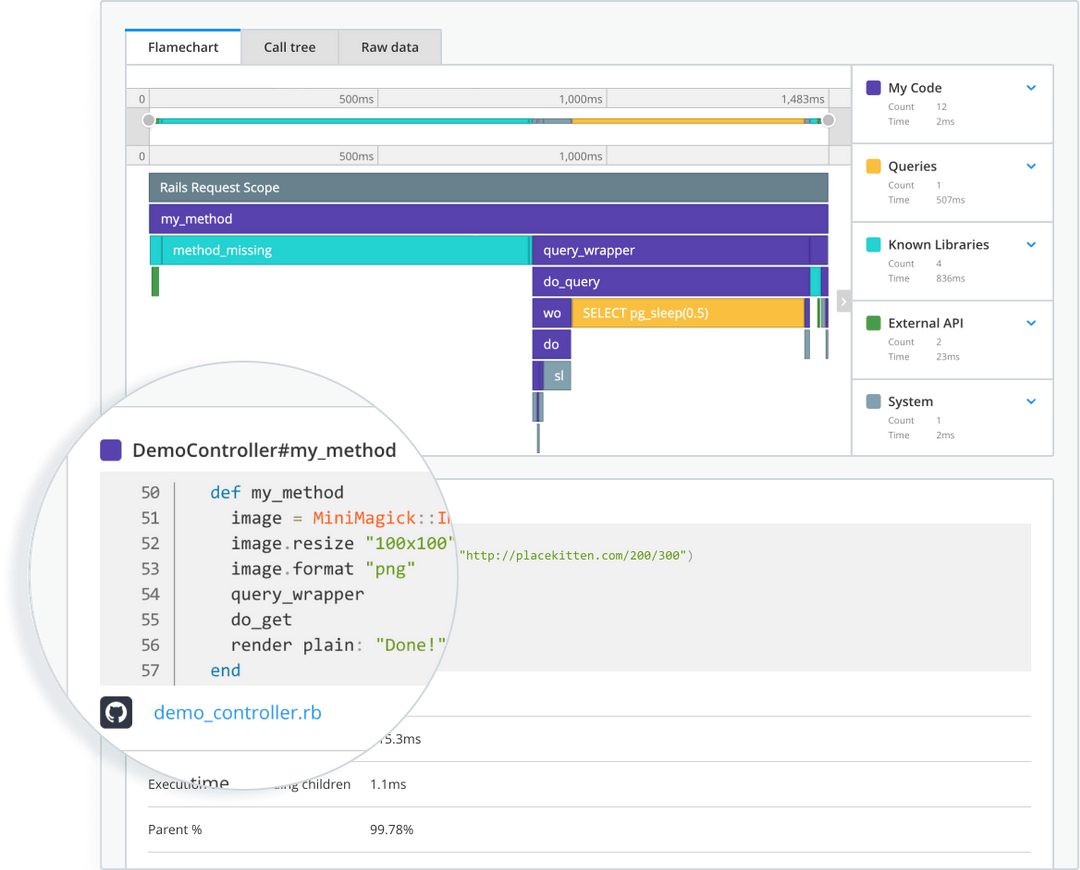
Raygun is a full-stack performance and error monitoring solution that gives you actionable, real-time insights into the quality of your web and mobile applications. Raygun provides a suite of monitoring tools, notably error monitoring and application performance monitoring (APM). Raygun APM provides visibility into the performance of applications, capturing metrics such as response time, latency, and throughput, and helping teams proactively detect performance issues and identify bottlenecks.
Raygun helps in pinpointing the root causes of performance issues with detailed insights into application behavior and transaction traces. This enables DevOps teams to quickly diagnose issues and reduce mean time to resolution (MTTR).
Raygun’s tool is “plug-and-play” and non-intrusive via language-specific tracers with low overhead. The heart of the tool is the intuitive flamechart representation of the lifecycle of a request, showing from start to finish what threads the request spun up, the methods it called and the external services and databases queries it made. It also includes features to manage issues, with automated prioritization, collaboration on tasks, assigning tasks to team members, and setting up automatic responses to triggers. It can facilitate collaboration between development and operations teams with comprehensive issue management, identifying, managing, and optimizing performance issues.
27. Opsgenie
Opsgenie is a cloud-based incident management and alerting tool to help teams effectively respond to incidents. It consists of a centralized platform for receiving, processing, and tackling alerts and incidents from a range of monitoring and logging tools.
Opsgenie lets you define your chosen alerting and incident management workflows and route alerts to the right teams based on severity, the system or application affected, or your selected criteria. It’s designed to help organizations respond to incidents faster, allowing users to collaborate in real-time to diagnose and resolve incidents, and providing an incident timeline, including alerts, notes, and status changes. Opsgenie also helps with incident data analysis, providing reports on incidents and alerts, including metrics such as mean time to acknowledge (MTTA) and mean time to resolution (MTTR).
Opsgenie supports integrations with popular logging and monitoring tools like Nagios and Datadog, as well as with cloud platforms such as AWS, Azure, and Google Cloud Platform.
28. Nagios: Infrastructure monitoring system
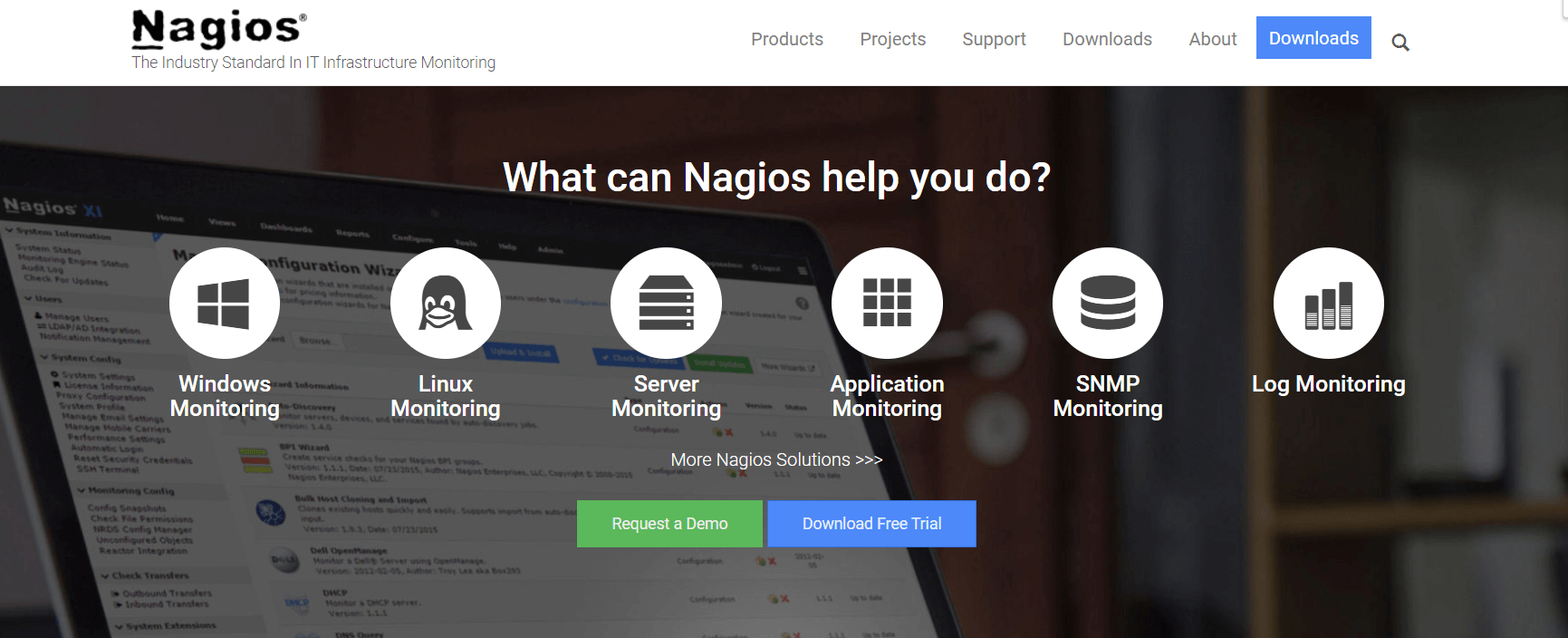
Nagios is one of the most popular free and open-source DevOps monitoring tools. It helps you monitor your infrastructure to find and fix problems. With Nagios, you can keep records of events, outages, and failures.
You can also keep an eye on trends using Nagios’ graphs and reports. This way, you can forecast outages and errors and detect security threats. Although there are many DevOps tools for infrastructure monitoring, Nagios stands out due to its rich plugin ecosystem.
Nagios offers four open-source monitoring solutions: Nagios Core is a command line tool, Nagios XI provides you with a web-based GUI (graphical user interface) and monitoring wizard, Nagios Log Server lets you search log data and set up alerts about potential threats, and Nagios Fusion allows you to monitor multiple networks at the same time.
As Nagios is a free tool, you’ll need to configure it yourself. Alternatively, you can opt for one of their support plans to access to the help and expertise of the Nagios team.
29. Firebase Crashlytics
Firebase is a platform developed by Google for creating mobile and web applications. Crashlytics is a free Crash Reporting tool included in the Firebase suite. You can use Firebase products to monitor app experience, build new features and sustain user-centric development.
Crashlytics provides real-time crash reporting, analytics, and insights to help developers quickly diagnose and resolve issues that may be affecting their users. It can automatically group similar crashes together and notify developers when a new issue is detected, allowing them to address the issue before it affects more users. Crash reports include stack traces, device information, and other contextual data, making it easier for developers to identify the root cause of the issue.
Firebase Crashlytics is designed to integrate seamlessly with Firebase, Google’s mobile app development platform. It provides a range of integration options, including native SDKs for iOS and Android, as well as with popular mobile development frameworks such as React Native and Flutter. Firebase provides a wide range of services that work seamlessly together, simplifying app development as a whole. However, this does mean that their error tracking functionality is only one of many things that they do, so if you’re looking for a full-featured Error Monitoring solution, you may find Crashlytics frustrating.
| Feature | Raygun | OpsGenie | Nagios | Firebase Crashlytics |
|---|---|---|---|---|
| Real-time Error Monitoring | ✔ | ✔ | ✘ | ✔ |
| Error Aggregation and Grouping | ✔ | ✔ | ✔ | ✔ |
| Alerting and Notification | ✔ | ✔ | ✔ | ✔ |
| Error Analytics and Insights | ✔ | ✘ | ✘ | ✔ |
| Integration and Compatibility | ✔ | ✔ | ✔ | ✔ |
Which DevOps tools are right for your team?
Finding the best DevOps tools for your specific requirements takes some testing and experimentation. Open-source tools tend to take more time to set up and configure, while most commercial DevOps tools come with free trials that allow you to test and evaluate them at no cost. Ultimately, the decision comes down to what you’re trying to achieve and the resources you have available. While the process of selecting and implementing your toolkit might require some time up front, once you have it in place, you’ll reap the benefits of a more cohesive development workflow.

